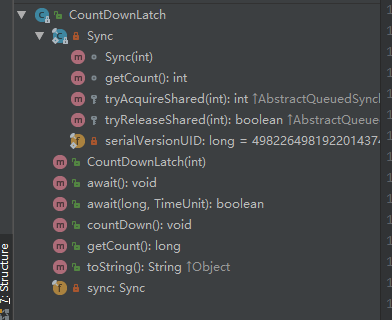线程池中的栅栏
多线程中有三个类,分别是CountDownLatch,CyclicBarrier,Semaphore。代表着线程中的栅栏。共享锁。
CountDownLatch
在一组线程中,一个线程等待其他线程。我把它理解为门栓。
查看该类的数据结构图如下图一

图一
有一个静态的内部类,Sync继承自AQS。
- CountDownLatch(int) : 有参构造方法,该类拥有的共享锁次数。
- await() : 阻塞,等待该类释放掉共享锁,也就是说,拥有共享锁的次数为0
- countDown:释放一次共享锁
- getCount: 获取共享锁次数
使用例子:代码如下:
/**
* @ClassName CountDownLatchTest
* @Description 共享锁。在完成一组正在其他线程中执行的操作之前,允许一个或者多个线程一直等待
* @Author ouyangkang
* @Date 2018/10/23 14:33
**/
public class CountDownLatchTest {
private static int SIZE = 6;
private static CountDownLatch countDownLatch;
/**
* @Date 2018/10/25 15:49
* @Description 阻塞队列为3 核心池的大小为2 最大池的大小为6的线程池
**/
private static ThreadPoolExecutor threadPoolExecutor = new ThreadPoolExecutor(
2, 6, 60L,TimeUnit.SECONDS, new LinkedBlockingDeque<>(3));
public static void main(String[] args) {
countDownLatch = new CountDownLatch(SIZE);
for (int i = 0; i < 6; i++) {
threadPoolExecutor.execute(new ThreadTest());
}
try {
// 阻塞等待
countDownLatch.await();
System.out.printf("thread main = [{%s}] \n", Thread.currentThread().getName());
threadPoolExecutor.shutdown();
} catch (InterruptedException e) {
e.printStackTrace();
}
}
static class ThreadTest extends Thread {
@Override
public void run() {
System.out.printf("thread-name = [%s] \n", Thread.currentThread().getName());
try {
Thread.sleep(10000);
} catch (InterruptedException e) {
e.printStackTrace();
}
System.out.printf("thread-name =[%s] 执行 \n", Thread.currentThread().getName());
// 数值减一
countDownLatch.countDown();
}
}
}
返回结果:
thread-name = [pool-1-thread-1]
thread-name = [pool-1-thread-3]
thread-name = [pool-1-thread-2]
thread-name =[pool-1-thread-1] 执行
thread-name =[pool-1-thread-3] 执行
thread-name = [pool-1-thread-1]
thread-name = [pool-1-thread-3]
thread-name =[pool-1-thread-2] 执行
thread-name = [pool-1-thread-2]
thread-name =[pool-1-thread-1] 执行
thread-name =[pool-1-thread-3] 执行
thread-name =[pool-1-thread-2] 执行
thread main = [{main}]
- 线程池中阻塞队列为3,启动了6个线程。阻塞队列中阻塞3个,核心池2个在执行任务,最大池的大小为6,那么就会新建一个线程来处理该任务。
- 主线程最后执行,wait等待其他线程任务执行完毕,再继续执行主线程。
CyclicBarrier
在一组线程中允许多个线程相互等待。就是,每个线程都先执行一下,然后互相等待到一个点。然后再执行。
查看该类的数据结构图

有参构造方法,设置屏障点是多少,创建线程,等待。直到线程数量大于等于该屏障点。处于该屏障点等待得线程全部唤醒。
使用例子如下:
/**
* @ClassName CyclicBarrierTest
* @Description 屏障,允许多个线程相互等待。到达了某一个临界点,就唤醒所有线程
* @Author ouyangkang
* @Date 2018/10/23 15:00
**/
public class CyclicBarrierTest {
private static int SIZE = 5;
private static CyclicBarrier cyclicBarrier;
public static void main(String[] args) {
cyclicBarrier = new CyclicBarrier(SIZE);
for (int i = 0; i < 5 ;i++){
new ThreadTest().start();
}
}
static class ThreadTest extends Thread {
@Override
public void run() {
System.out.printf("thread=[%s] 开始-- \n", Thread.currentThread().getName());
try {
Thread.sleep(1000);
cyclicBarrier.await();
System.out.printf("thread=[%s] 继续--- \n", Thread.currentThread().getName());
} catch (InterruptedException e) {
e.printStackTrace();
} catch (BrokenBarrierException e) {
e.printStackTrace();
}
}
}
}
结果如下:
thread=[Thread-0] 开始--
thread=[Thread-4] 开始--
thread=[Thread-3] 开始--
thread=[Thread-1] 开始--
thread=[Thread-2] 开始--
thread=[Thread-2] 继续---
thread=[Thread-4] 继续---
thread=[Thread-0] 继续---
thread=[Thread-1] 继续---
thread=[Thread-3] 继续---
Semaphore
在一组线程中,线程持有信号量,如果信息量得大小为10,那么所有线程能够持有得信号量不能超过10,如果3个线程分别持有得信号量是3 4 5 。 那么只能是两个线程运行,当其中一个释放了该信号量,其他线程才可以运行。
类图结构如下:

具体例子如下:
/**
* @ClassName SemaphoreTest
* @Description 信号量
* @Author ouyangkang
* @Date 2018/10/23 16:34
**/
public class SemaphoreTest {
private static int SIZE = 10;
public static void main(String[] args) {
Semaphore semaphore = new Semaphore(SIZE);
ExecutorService executorService = new ThreadPoolExecutor(2,3,60L,TimeUnit.SECONDS,new LinkedBlockingQueue<>(5));
executorService.execute(new ThreadTest(3,semaphore));
executorService.execute(new ThreadTest(4,semaphore));
executorService.execute(new ThreadTest(5,semaphore));
executorService.shutdown();
}
static class ThreadTest extends Thread{
private Integer count ;
private Semaphore semaphore;
public ThreadTest(Integer count , Semaphore semaphore){
this.count = count ;
this.semaphore = semaphore;
}
@Override
public void run() {
try {
semaphore.acquire(count);
System.out.printf("thread=[%s] 拥有信号量 semaphore=[%d] 开始---- \n",Thread.currentThread().getName(), count);
Thread.sleep(1000);
} catch (InterruptedException e) {
e.printStackTrace();
}finally {
semaphore.release(count);
System.out.printf("thread=[%s] 释放了 semaphore=[%d] --\n",Thread.currentThread().getName(),count);
}
}
}
}
具体结果如下:
thread=[pool-1-thread-2] 拥有信号量 semaphore=[4] 开始----
thread=[pool-1-thread-1] 拥有信号量 semaphore=[3] 开始----
thread=[pool-1-thread-2] 释放了 semaphore=[4] --
thread=[pool-1-thread-2] 拥有信号量 semaphore=[5] 开始----
thread=[pool-1-thread-1] 释放了 semaphore=[3] --
thread=[pool-1-thread-2] 释放了 semaphore=[5] --


 浙公网安备 33010602011771号
浙公网安备 33010602011771号